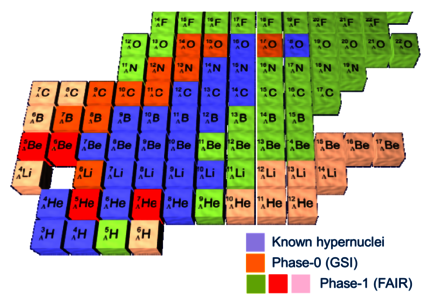Exotic hypernuclei and their properties
Lambda (Λ) particles can be produced by peripheral collisions at incident energies around 1…2 A GeV. These Λ-particles may coalesce with the projectile fragments to form Λ-hypernuclei. The invariant mass of the final state, for example a π- and a nuclear fragment after weak decay of hypernuclei, gives an effective signature for identifying a hypernucleus. One of the unique features of hypernuclear spectroscopy with projectile fragmentation is that, due to a large Lorentz factor of the produced hypernuclei, the decay can be observed in flight behind the production target. The half-life of an observed hypernuclei can be determined from the distribution of the flight length before it decays. Heavy-ion collisions also provide a possibility for forming multi-Λ hypernuclei. As a further development, the Super-FRS with addition of a pion detector just downstream of the target at the central focal plane of the main separator, would provide efficient and high-mass resolution measurements.
Such a method of production of hypernuclei has been already demonstrated at GSI facility by the HypHI collaboration. They performed the first experiment with Li (Z=6) projectiles at 2 A GeV on a carbon target. Signals indicating the production of light hypernuclei Z=3 ΛH and Z=4 ΛH were observed. The half lives were also extracted.The hypernuclei which could be produced at FAIR are shown in picture drastic expansion of the hypernuclear chart is expected.


